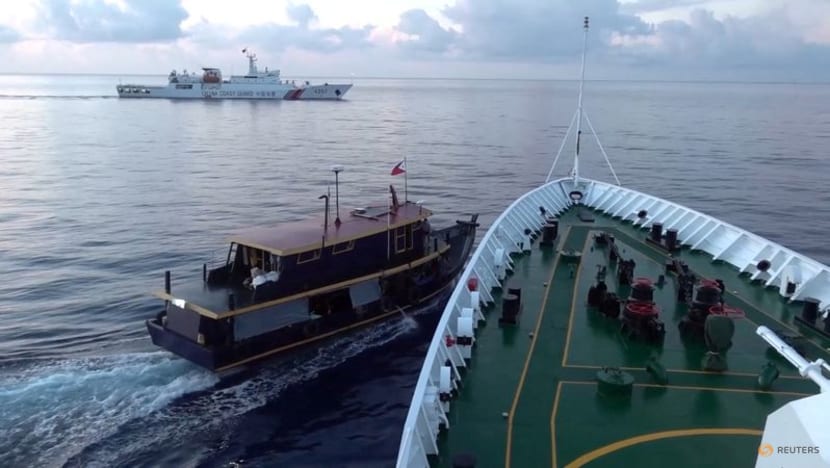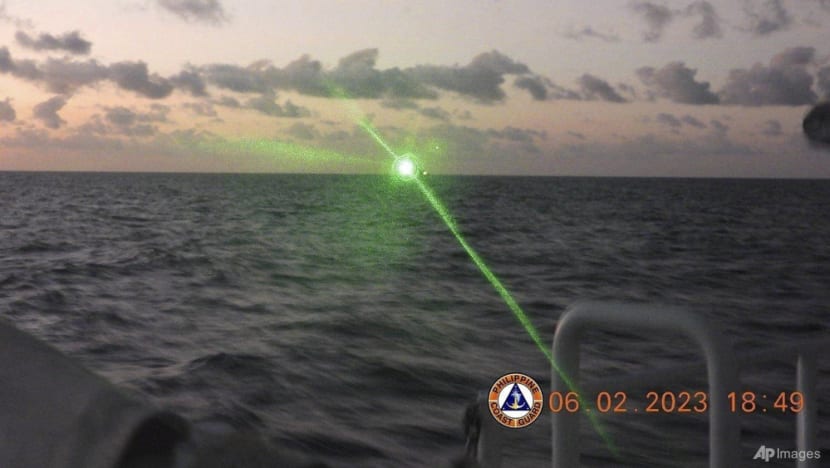Commentary: South China Sea isn’t the place to play ‘game of chicken’
After Chinese and Philippine vessels collided off the disputed Second Thomas Shoal, one question arises: Is this the one that triggers a US-China clash? RSIS’ Collin Koh weighs in.

This audio is AI-generated.
SINGAPORE: The collision between a Chinese coast guard vessel and a Philippine resupply boat off the Second Thomas Shoal on Sunday (Oct 22) is the latest in a long series of flare-ups in the South China Sea.
And every time an incident happens, one question invariably arises: Will this be the one that sparks a more serious confrontation between China and the United States?
Tensions have been ratcheting up. In February, the Philippines accused the Chinese of shining a “military-grade laser light” and temporarily blinding crew members of a patrol vessel. In August, China allegedly fired a water cannon at a Philippine resupply mission to its grounded warship that serves as a military outpost.
For now at least, the vibes coming from Beijing, Manila and Washington don’t seem to reflect any desire for the latest altercation to erupt into anything with more unimaginable consequences.
Chinese President Xi Jinping expressed the desire to cooperate and peacefully address differences with the US. American President Joe Biden reiterated US commitment to defend its ally, should the Philippines come under attack in the South China Sea, but also showed no desire for war. Manila, while emphasising its sovereign rights over the disputed shoal, made it clear the country isn’t at war with China.
It is important to cut through the rhetoric and discern what dissuades them from crossing the threshold into the use of kinetic force.
NO ONE WANTS ESCALATION IN SOUTH CHINA SEA
The truth is, escalation in the South China Sea is the last thing anyone needs.
China appears to be more interested in pulling its economy out of the doldrums; maintaining an unyielding posture in the South China Sea will suffice. The United States finds itself inextricably tied to two concurrent wars in Europe and the Middle East and may have no stomach for a “third front” in Asia, especially ahead of a presidential election.
While not relenting on its stance over the Second Thomas Shoal, the Philippines still has a host of domestic and economic challenges to devote attention to, and an armed conflict will undermine efforts for recovery.
US-China ties have also been warming up through painstaking effort. Beijing and Washington just commenced this week their inaugural economic working group meeting. After a flurry of high-level interactions over the past months, Chinese foreign minister Wang Yi is now in Washington - the highest-ranking official to visit in nearly five years - paving the way for a summit between Mr Biden and Mr Xi in November.
Things are looking up even on the contentious military-to-military front. The US defence department will send a delegation to attend the Xiangshan Forum this weekend. The formal removal of Li Shangfu as defence minister - regarded by some as an impediment to high-level military dialogues, being subjected to US sanctions - may provide a new opening.
EVERY MISCALCULATION COULD BE A SPARK
While the risk of premeditated war does not appear to be high, no one should discount the possibility of accidental conflict.
The South China Sea is a tinderbox. A miscalculation or misjudgment of the situation on the ground could possibly set things spinning out of control, considering the close proximity of rival maritime forces and frayed nerves.
History tells us past flare-ups have fortuitously not escalated into bigger confrontations. Call it cold comfort, given the situation is constantly evolving and mired in uncertainty, but it should be noted that the parties displayed typical tendencies to de-escalate, not escalate.

The American warship USS Dewey was observed near where the latest collision happened - something the Chinese could not have missed. This might have deterred them from undertaking more drastic actions. Beijing was possibly testing how far Washington was willing to support Manila.
In the near future, the situation revolving around the Second Thomas Shoal looks set to be even more uncertain. For one, the Philippines would now be thinking hard about the long-term future of the rusting warship BRP Sierra Madre.
The latest incident involved Philippine vessels carrying materials for ship repairs, so tougher Chinese reactions can’t be ruled out if Manila decides to undertake construction of a permanent outpost.
BETWEEN A ROCK AND A HARD PLACE
There have been calls for the US to be involved in the Philippine resupply missions to Second Thomas Shoal. Such an eventuality would test the credibility of both Beijing and Washington.
On the one hand, China may be forced to show its hand by undertaking more forceful actions to stop the missions. On the other, doing this would risk direct confrontation with American forces. This puts China between a rock and a hard place.
All eyes will also be on Washington to see if it demonstrates less-than-desired resolve to back up a formal treaty ally. Yet a joint escort for resupply runs would strain existing capacities and potentially enter direct confrontation with the Chinese.
Manila appears more wary, having stressed that China’s aggressive behaviour to date would have to be assessed in determining the applicability of the mutual defence treaty with Washington.
That said, the possibility of a joint Philippine-US effort to resupply Second Thomas Shoal would become higher if Beijing shows no or little inclination to stand down from its aggressive blockading actions. It would therefore behove China to refrain from escalating beyond what it is already doing, lest it decides to gamble in a “game of chicken” to further test American resolve.
Unless of course, Beijing concludes that Washington will be the first to blink. This would definitely set the two powers on a course of collision in the South China Sea.
Collin Koh is senior fellow at the S Rajaratnam School of International Studies, based in Nanyang Technological University, Singapore.









